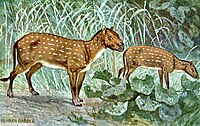User:Abyssal/Portal:Paleogene
IntroductionThe Paleogene Period (IPA: /ˈpeɪli.ədʒiːn, -li.oʊ-, ˈpæli-/ PAY-lee-ə-jeen, -lee-oh-, PAL-ee-; also spelled Palaeogene or Palæogene) is a geologic period and system that spans 43 million years from the end of the Cretaceous Period 66 Ma (million years ago) to the beginning of the Neogene Period 23.03 Ma. It is the first period of the Cenozoic Era and is divided into the Paleocene, Eocene, and Oligocene epochs. The earlier term Tertiary Period was used to define the time now covered by the Paleogene Period and subsequent Neogene Period; despite no longer being recognized as a formal stratigraphic term, "Tertiary" still sometimes remains in informal use. Paleogene is often abbreviated "Pg", although the United States Geological Survey uses the abbreviation "Pe" for the Paleogene on the Survey's geologic maps. During the Paleogene period, mammals continued to diversify from relatively small, simple forms into a large group of diverse animals in the wake of the Cretaceous–Paleogene extinction event that ended the preceding Cretaceous Period. (Full article...) Selected article on the Paleogene world and its legacies The shell of a bivalve is composed of calcium carbonate, and consists of two, usually similar, parts called valves. These are joined together along one edge by a flexible ligament that, in conjunction with interlocking "teeth" on each of the valves, forms the hinge. The shell is typically bilaterally symmetrical, with the hinge lying in the sagittal plane. Adult shell sizes vary from fractions of a millimetre to over a metre in length, but the majority of species do not exceed 10 cm (4 in). Bivalves appear in the fossil record first in the early Cambrian more than 500 million years ago. The total number of living species is approximately 9,200. These species are placed within 1,260 genera and 106 families. Marine bivalves (including brackish water and estuarine species) represent about 8,000 species, combined in four subclasses and 99 families with 1,100 genera. The largestrecent marine family is the Veneridae, with more than 680 species. (see more...) Did you know?
Need help?Do you have a question about Abyssal/Portal:Paleogene that you can't find the answer to? Consider asking it at the Wikipedia reference desk. Selected image
Selected article on the Paleogene in human science, culture and economics
Oil shale geology is a branch of geologic sciences which studies the formation and composition of oil shales–fine-grained sedimentary rocks containing significant amounts of kerogen, and belonging to the group of sapropel fuels. Oil shale formation takes place in a number of depositional settings and has considerable compositional variation. Oil shales can be classified by their composition (carbonate minerals such as calcite or detrital minerals such as quartz and clays) or by their depositional environment (large lakes, shallow marine, and lagoon/small lake settings). Much of the organic matter in oil shale is of algal origin, but may also include remains of vascular land plants. Three major type of organic matter (macerals) in oil shale are telalginite, lamalginite, and bituminite. Some oil-shale deposits also contain metals which include vanadium, zinc, copper, uranium.
Most oil shale deposits were formed during Middle Cambrian, Early and Middle Ordovician, Late Devonian, Late Jurassic, and Paleogene times through burial by sedimentary loading on top of the algal swamp deposits, resulting in conversion of the organic matter to kerogen by diagenetic processes. The largest deposits are found in the remains of large lakes such as the deposits of the Green River Formation of Wyoming and Utah, USA. Oil-shale deposits formed in the shallow seas of continental shelves generally are much thinner than large lake basin deposits. (see more...) TopicsGeochronology - Paleogene (Paleocene - Eocene - Oligocene) Paleogene landmasses - Major Paleogene events - Paleogene biota appearances - Fossil sites - Stratigraphic units - History - History of paleontology - Timeline of paleontology Researchers - Culture - Treatise on Invertebrate Paleontology - Vertebrate Paleontology SubcategoriesQuality ContentThings you can doRelated contentAssociated WikimediaThe following Wikimedia Foundation sister projects provide more on this subject:
|




















